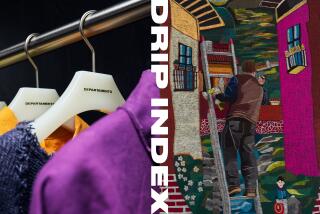Inner-city expressions
WHAT is the ghetto?
On the one hand, it’s a literal space, erected from barriers of race and class. But it’s also a metaphorical space, a set of stereotypes about communities and cultures, an adjective with clashing connotations.
As hip-hop American parlance would put it, one had better avoid “ghetto” behavior, but strive to be “ghetto fabulous.” This last term, a seeming paradox popular with rappers and designers alike, mystified Isabelle Lutterodt and Karin Pleasant, graduates of California Institute for the Arts.
“We started wondering about the meaning of ‘ghetto fabulous,’ ” Pleasant says. “Is it positive or negative? Was it coined by ghetto dwellers? Why is it tossed around so freely, and how did the term evolve?”
Posing these questions to 10 artists eventually gave birth to “Ghetto Fabulous,” an exhibit, curated by Lutterodt and Pleasant, first at the Watts Towers Arts Center late last year, and now at the Armory Center for the Arts’ Northwest Gallery in Pasadena through Sunday.
The questions reverberate -- literally -- through the gallery, where a television features artists ruminating on the exhibit’s deceptively simple title.
For some, “ghetto fabulous” means transforming literal and figurative scraps of life into something glorious. Los Angeles-born Castillo, for instance, constructs “Ghetto’s Rose” out of artificial roses purchased at 7-Eleven, while Rosalyn Myles’ “Pearl,” a multimedia installation video, re-creates a Watts trailer that once housed her gay neighbor: Behind a facade of dirt and metal is a cozy home, an oasis where a silk robe rests beside a gold ashtray and a well-worn Baldwin volume.
For other artists, born of the suburbs, the ghetto is an imaginary construct. Ian Dale parodies his ghetto ignorance in “I Don’t Know Anything About the Ghetto,” for which he researched the ghetto, as he puts it in his disclaimer, “the same way I learn about everything else: by watching lots of movies.” His brightly colored digital painting, which was featured in the now-closed Watts exhibit, is a cartoon gone awry, a gory rendering of every stereotype about South-Central L.A.
Like the Studio Museum of Harlem’s acclaimed “Freestyle” exhibit, “Ghetto Fabulous” showcases an up-and-coming generation of artists, products of the cultural hodgepodge that is hip-hop America -- artists who are at ease with the quandaries of race.
Instead of smoothing out cultural and stylistic differences, “Ghetto Fabulous” celebrates them, placing, for instance, Miyo Stevens-Hernandez’s “Afuera/Outside” -- realistic photos of everyday locales in El Monte -- beside Michael Garnes’ “Ghetto Fabulous Life,” an intentionally unreal board-game version of New York (and the only realm in which the Lubavitcher Rabbi and rapper Flavor Flav stand in proximity).
“We wanted to demonstrate the ways in which this culture is interpreted differently by artists,” Pleasant says.
The physical geography of the ghetto is a recurrent theme of the exhibit, situated in the contrasting venues of contemporary America: urban Watts, which fulfills many ghetto fantasies, and suburban Pasadena, which does anything but. Artist Kendell Carter bridges the two spaces in his “Shoot the Gift,” an installation that projects Watts graffiti onto a staid Pasadena landscape.
At a time when suburban hip-hop fans pay top dollar to look more “ghetto” than actual ghetto dwellers, Carter’s work, a merging of hip-hop aesthetics and modernist architecture, speaks volumes.
The Armory Center’s starkly bare setting -- it has the feel of a converted warehouse instead of a museum -- allows the exhibited work to speak for itself. It is an ideal space for Castillo’s “Ecliptic Eccentricity,” five enormous balls of hair -- four black and one blond -- suspended like pendulums from the ceiling, challenging our ideas about race and power.
An entire wall is devoted to John Trevino and Connie Martin’s “Urban Alchemy,” a 5-by-43-foot mixed-media mural exploring the consumerism of ghetto culture. “Louis Vuitton doesn’t know about you,” reads one end; beneath it: “Lexus won’t give you a car if you name your child after them.”
Attached to the mural are photographs of hair salons, half-dressed mannequins, a car rim -- all of which make the piece about commodity culture as well as a commodity itself.
The exhibition’s art celebrates and critiques the quest for “ghetto fabulousness.” It is art that encapsulates, in other words, the paradoxes and complexities of the “Ghetto Fabulous” exhibit itself.
*
‘Ghetto Fabulous’
Where: Armory Northwest, 965 Fair Oaks Ave., Pasadena
When: Saturday and Sunday, noon-5 p.m.
Ends: Sunday
Price: Admission is free
Info: (626) 792-5101
More to Read
The biggest entertainment stories
Get our big stories about Hollywood, film, television, music, arts, culture and more right in your inbox as soon as they publish.
You may occasionally receive promotional content from the Los Angeles Times.










